MIA ME503 Industrial Process Control Systems Assignment 2 V3.0
VerifiedAdded on 2023/06/07
|9
|2210
|260
Homework Assignment
AI Summary
This document provides a solution to an assignment on Industrial Process Control Systems, focusing on current and future trends in industrial automation, AC drives, and synchronous motors. It discusses the benefits and applications of synchronous motors, including their use in maintaining constant speed and power factor correction. The assignment also explores new applications of power electronics in the power energy industry, such as the use of microgrids and multilevel converters for renewable energy integration. Additionally, it includes calculations related to circuit analysis and transistor parameters. Desklib offers more solved assignments and resources for students.
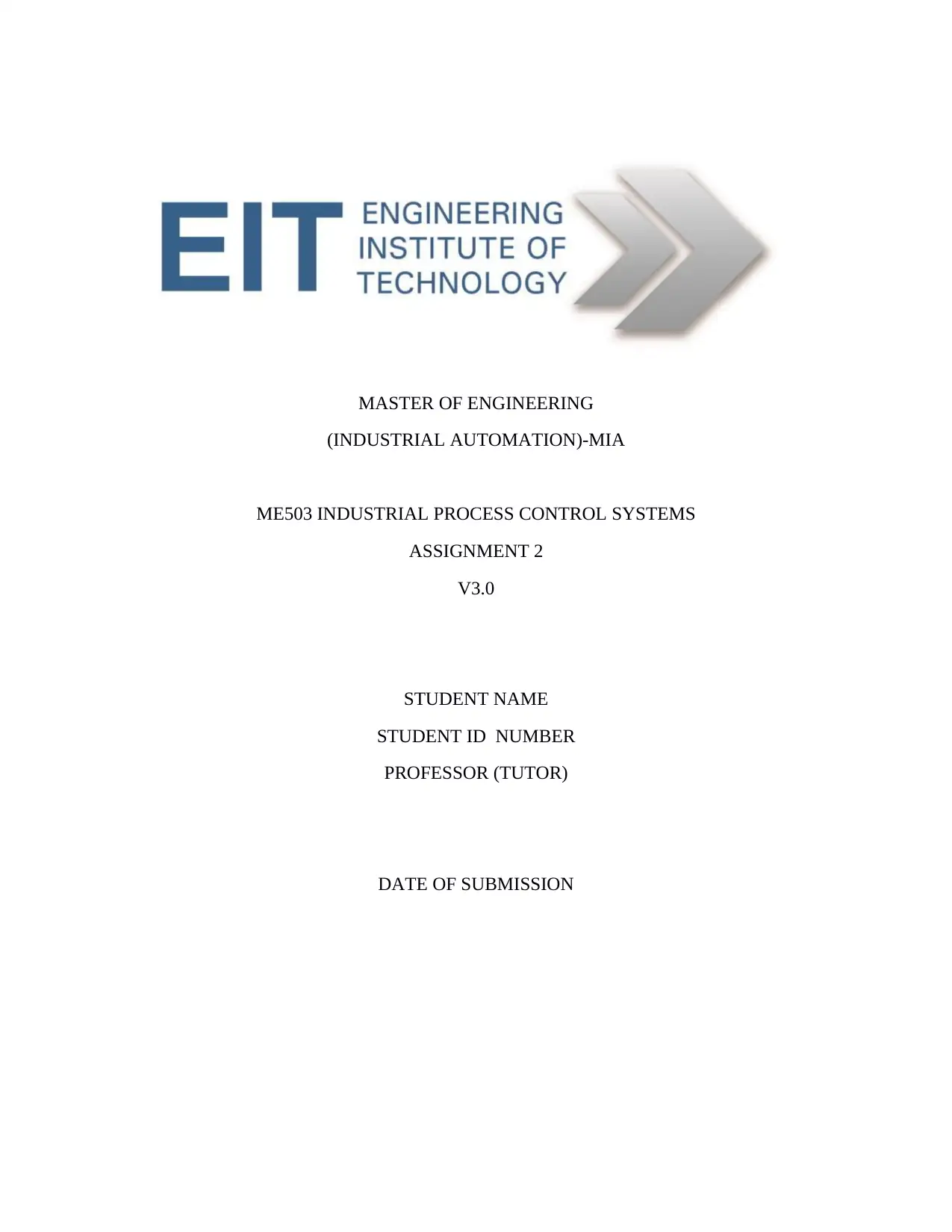
MASTER OF ENGINEERING
(INDUSTRIAL AUTOMATION)-MIA
ME503 INDUSTRIAL PROCESS CONTROL SYSTEMS
ASSIGNMENT 2
V3.0
STUDENT NAME
STUDENT ID NUMBER
PROFESSOR (TUTOR)
DATE OF SUBMISSION
(INDUSTRIAL AUTOMATION)-MIA
ME503 INDUSTRIAL PROCESS CONTROL SYSTEMS
ASSIGNMENT 2
V3.0
STUDENT NAME
STUDENT ID NUMBER
PROFESSOR (TUTOR)
DATE OF SUBMISSION
Paraphrase This Document
Need a fresh take? Get an instant paraphrase of this document with our AI Paraphraser
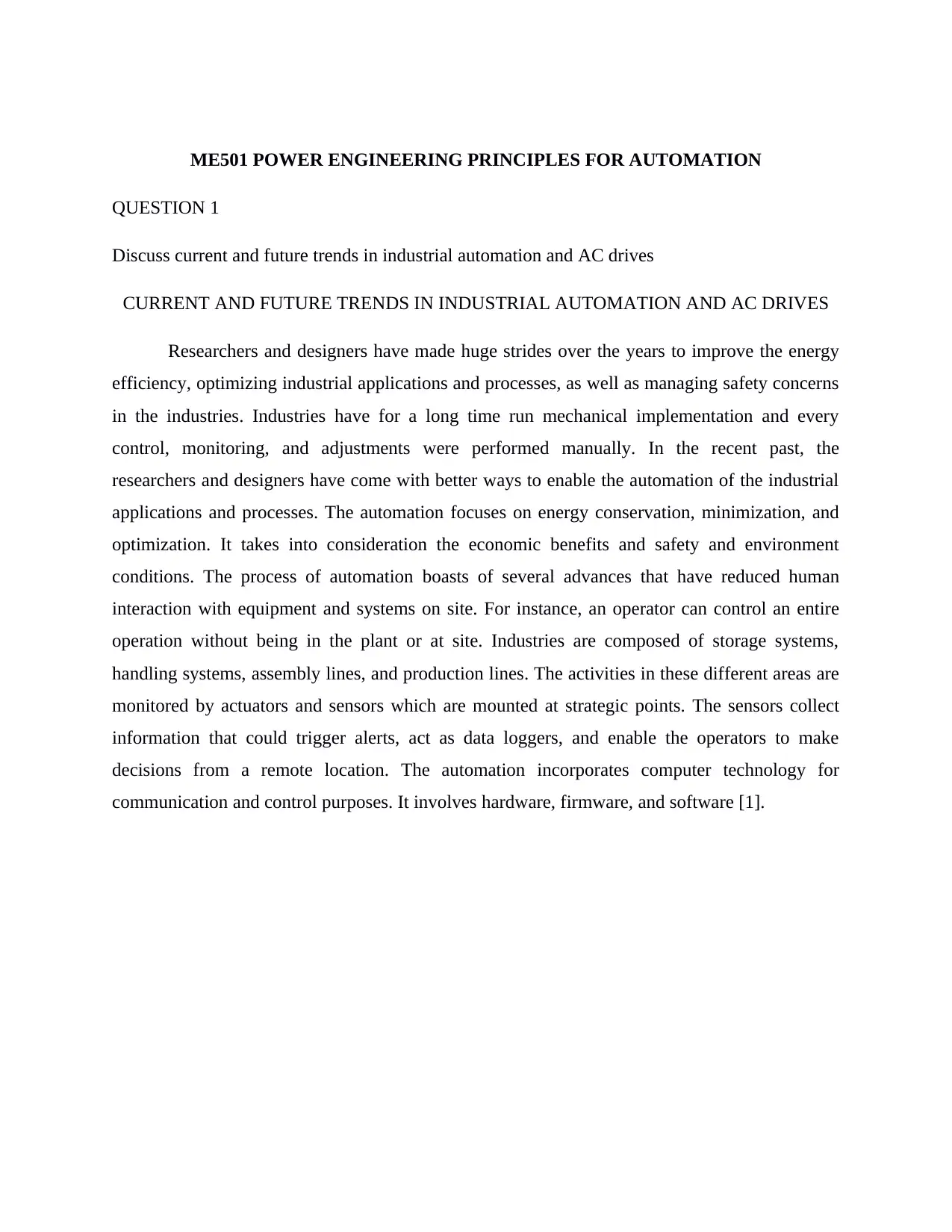
ME501 POWER ENGINEERING PRINCIPLES FOR AUTOMATION
QUESTION 1
Discuss current and future trends in industrial automation and AC drives
CURRENT AND FUTURE TRENDS IN INDUSTRIAL AUTOMATION AND AC DRIVES
Researchers and designers have made huge strides over the years to improve the energy
efficiency, optimizing industrial applications and processes, as well as managing safety concerns
in the industries. Industries have for a long time run mechanical implementation and every
control, monitoring, and adjustments were performed manually. In the recent past, the
researchers and designers have come with better ways to enable the automation of the industrial
applications and processes. The automation focuses on energy conservation, minimization, and
optimization. It takes into consideration the economic benefits and safety and environment
conditions. The process of automation boasts of several advances that have reduced human
interaction with equipment and systems on site. For instance, an operator can control an entire
operation without being in the plant or at site. Industries are composed of storage systems,
handling systems, assembly lines, and production lines. The activities in these different areas are
monitored by actuators and sensors which are mounted at strategic points. The sensors collect
information that could trigger alerts, act as data loggers, and enable the operators to make
decisions from a remote location. The automation incorporates computer technology for
communication and control purposes. It involves hardware, firmware, and software [1].
QUESTION 1
Discuss current and future trends in industrial automation and AC drives
CURRENT AND FUTURE TRENDS IN INDUSTRIAL AUTOMATION AND AC DRIVES
Researchers and designers have made huge strides over the years to improve the energy
efficiency, optimizing industrial applications and processes, as well as managing safety concerns
in the industries. Industries have for a long time run mechanical implementation and every
control, monitoring, and adjustments were performed manually. In the recent past, the
researchers and designers have come with better ways to enable the automation of the industrial
applications and processes. The automation focuses on energy conservation, minimization, and
optimization. It takes into consideration the economic benefits and safety and environment
conditions. The process of automation boasts of several advances that have reduced human
interaction with equipment and systems on site. For instance, an operator can control an entire
operation without being in the plant or at site. Industries are composed of storage systems,
handling systems, assembly lines, and production lines. The activities in these different areas are
monitored by actuators and sensors which are mounted at strategic points. The sensors collect
information that could trigger alerts, act as data loggers, and enable the operators to make
decisions from a remote location. The automation incorporates computer technology for
communication and control purposes. It involves hardware, firmware, and software [1].
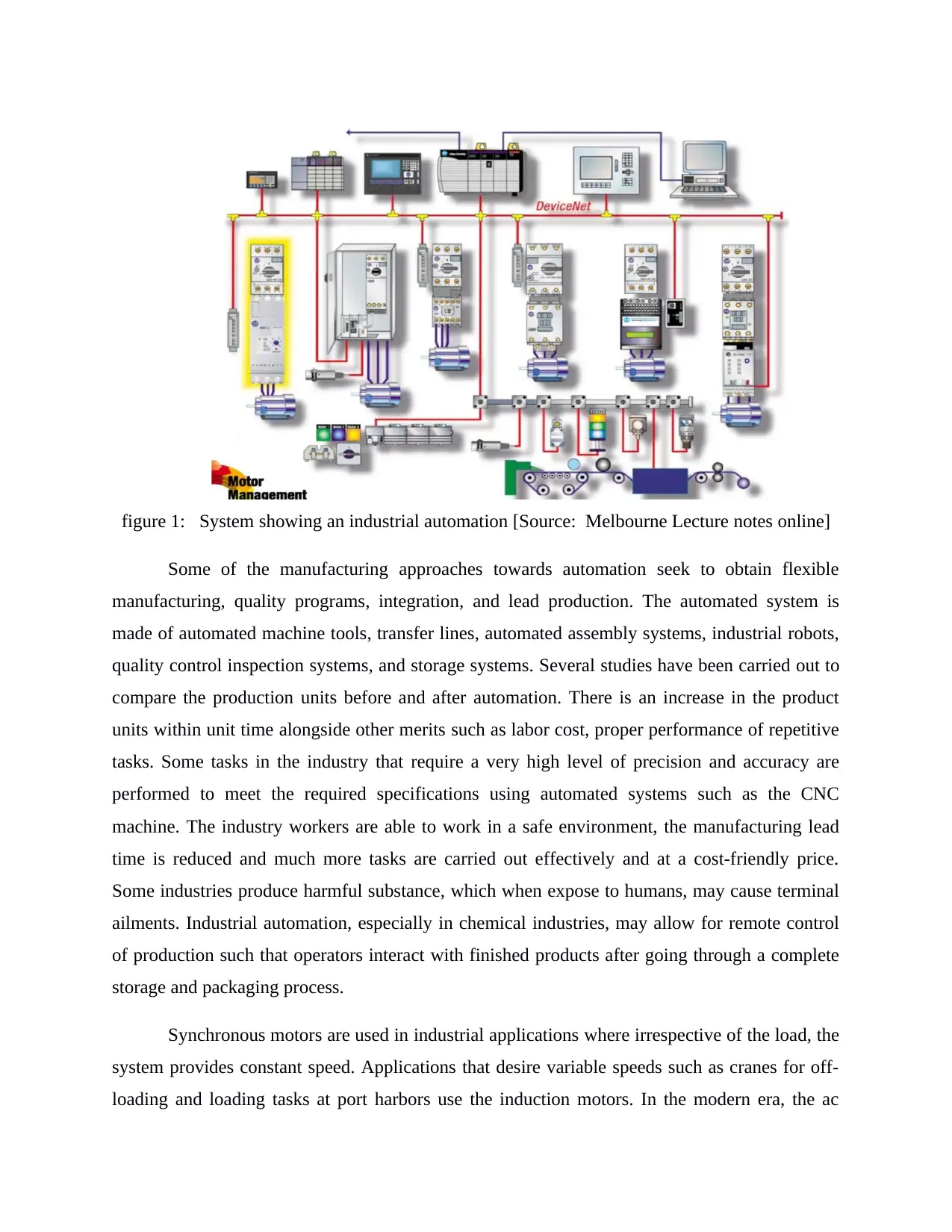
figure 1: System showing an industrial automation [Source: Melbourne Lecture notes online]
Some of the manufacturing approaches towards automation seek to obtain flexible
manufacturing, quality programs, integration, and lead production. The automated system is
made of automated machine tools, transfer lines, automated assembly systems, industrial robots,
quality control inspection systems, and storage systems. Several studies have been carried out to
compare the production units before and after automation. There is an increase in the product
units within unit time alongside other merits such as labor cost, proper performance of repetitive
tasks. Some tasks in the industry that require a very high level of precision and accuracy are
performed to meet the required specifications using automated systems such as the CNC
machine. The industry workers are able to work in a safe environment, the manufacturing lead
time is reduced and much more tasks are carried out effectively and at a cost-friendly price.
Some industries produce harmful substance, which when expose to humans, may cause terminal
ailments. Industrial automation, especially in chemical industries, may allow for remote control
of production such that operators interact with finished products after going through a complete
storage and packaging process.
Synchronous motors are used in industrial applications where irrespective of the load, the
system provides constant speed. Applications that desire variable speeds such as cranes for off-
loading and loading tasks at port harbors use the induction motors. In the modern era, the ac
Some of the manufacturing approaches towards automation seek to obtain flexible
manufacturing, quality programs, integration, and lead production. The automated system is
made of automated machine tools, transfer lines, automated assembly systems, industrial robots,
quality control inspection systems, and storage systems. Several studies have been carried out to
compare the production units before and after automation. There is an increase in the product
units within unit time alongside other merits such as labor cost, proper performance of repetitive
tasks. Some tasks in the industry that require a very high level of precision and accuracy are
performed to meet the required specifications using automated systems such as the CNC
machine. The industry workers are able to work in a safe environment, the manufacturing lead
time is reduced and much more tasks are carried out effectively and at a cost-friendly price.
Some industries produce harmful substance, which when expose to humans, may cause terminal
ailments. Industrial automation, especially in chemical industries, may allow for remote control
of production such that operators interact with finished products after going through a complete
storage and packaging process.
Synchronous motors are used in industrial applications where irrespective of the load, the
system provides constant speed. Applications that desire variable speeds such as cranes for off-
loading and loading tasks at port harbors use the induction motors. In the modern era, the ac
⊘ This is a preview!⊘
Do you want full access?
Subscribe today to unlock all pages.

Trusted by 1+ million students worldwide
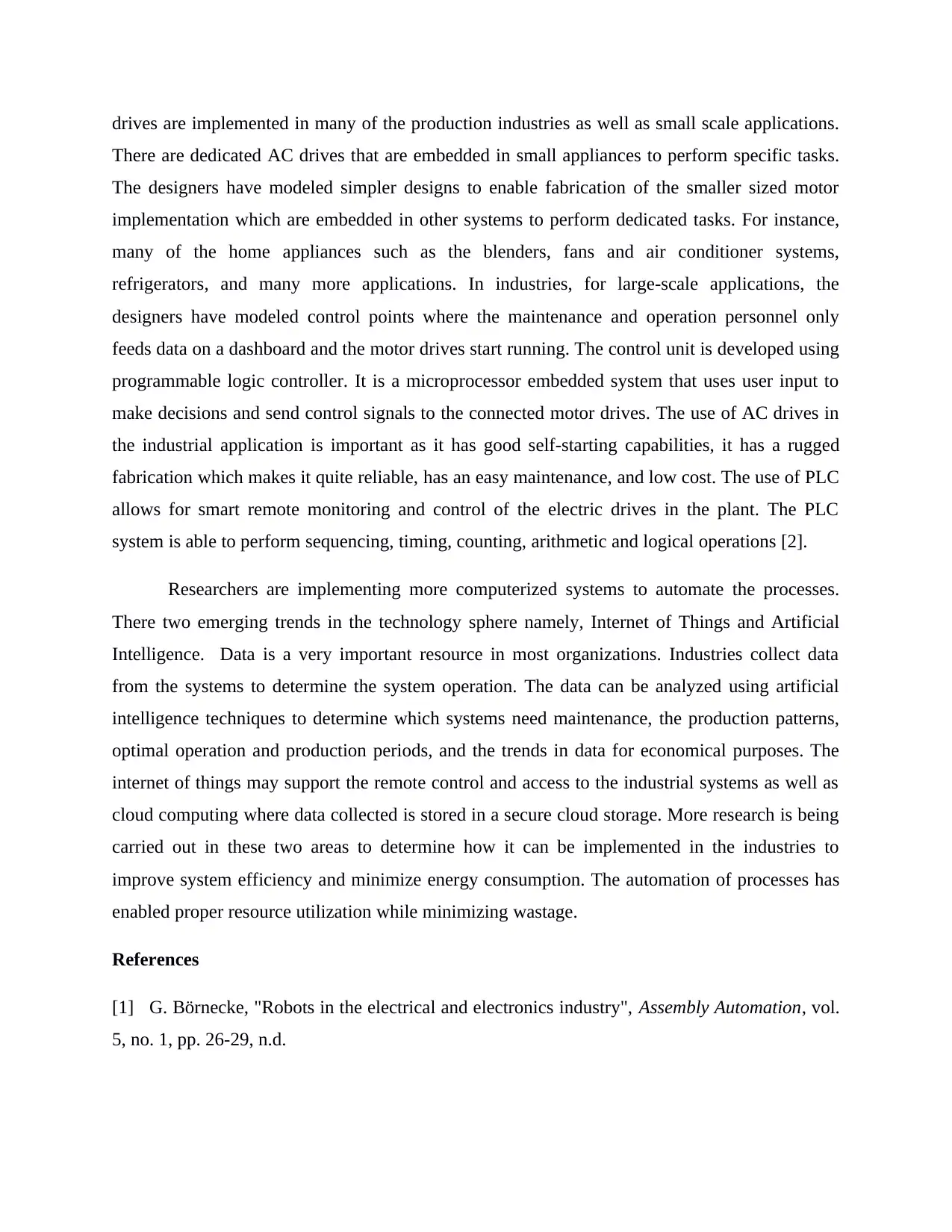
drives are implemented in many of the production industries as well as small scale applications.
There are dedicated AC drives that are embedded in small appliances to perform specific tasks.
The designers have modeled simpler designs to enable fabrication of the smaller sized motor
implementation which are embedded in other systems to perform dedicated tasks. For instance,
many of the home appliances such as the blenders, fans and air conditioner systems,
refrigerators, and many more applications. In industries, for large-scale applications, the
designers have modeled control points where the maintenance and operation personnel only
feeds data on a dashboard and the motor drives start running. The control unit is developed using
programmable logic controller. It is a microprocessor embedded system that uses user input to
make decisions and send control signals to the connected motor drives. The use of AC drives in
the industrial application is important as it has good self-starting capabilities, it has a rugged
fabrication which makes it quite reliable, has an easy maintenance, and low cost. The use of PLC
allows for smart remote monitoring and control of the electric drives in the plant. The PLC
system is able to perform sequencing, timing, counting, arithmetic and logical operations [2].
Researchers are implementing more computerized systems to automate the processes.
There two emerging trends in the technology sphere namely, Internet of Things and Artificial
Intelligence. Data is a very important resource in most organizations. Industries collect data
from the systems to determine the system operation. The data can be analyzed using artificial
intelligence techniques to determine which systems need maintenance, the production patterns,
optimal operation and production periods, and the trends in data for economical purposes. The
internet of things may support the remote control and access to the industrial systems as well as
cloud computing where data collected is stored in a secure cloud storage. More research is being
carried out in these two areas to determine how it can be implemented in the industries to
improve system efficiency and minimize energy consumption. The automation of processes has
enabled proper resource utilization while minimizing wastage.
References
[1] G. Börnecke, "Robots in the electrical and electronics industry", Assembly Automation, vol.
5, no. 1, pp. 26-29, n.d.
There are dedicated AC drives that are embedded in small appliances to perform specific tasks.
The designers have modeled simpler designs to enable fabrication of the smaller sized motor
implementation which are embedded in other systems to perform dedicated tasks. For instance,
many of the home appliances such as the blenders, fans and air conditioner systems,
refrigerators, and many more applications. In industries, for large-scale applications, the
designers have modeled control points where the maintenance and operation personnel only
feeds data on a dashboard and the motor drives start running. The control unit is developed using
programmable logic controller. It is a microprocessor embedded system that uses user input to
make decisions and send control signals to the connected motor drives. The use of AC drives in
the industrial application is important as it has good self-starting capabilities, it has a rugged
fabrication which makes it quite reliable, has an easy maintenance, and low cost. The use of PLC
allows for smart remote monitoring and control of the electric drives in the plant. The PLC
system is able to perform sequencing, timing, counting, arithmetic and logical operations [2].
Researchers are implementing more computerized systems to automate the processes.
There two emerging trends in the technology sphere namely, Internet of Things and Artificial
Intelligence. Data is a very important resource in most organizations. Industries collect data
from the systems to determine the system operation. The data can be analyzed using artificial
intelligence techniques to determine which systems need maintenance, the production patterns,
optimal operation and production periods, and the trends in data for economical purposes. The
internet of things may support the remote control and access to the industrial systems as well as
cloud computing where data collected is stored in a secure cloud storage. More research is being
carried out in these two areas to determine how it can be implemented in the industries to
improve system efficiency and minimize energy consumption. The automation of processes has
enabled proper resource utilization while minimizing wastage.
References
[1] G. Börnecke, "Robots in the electrical and electronics industry", Assembly Automation, vol.
5, no. 1, pp. 26-29, n.d.
Paraphrase This Document
Need a fresh take? Get an instant paraphrase of this document with our AI Paraphraser
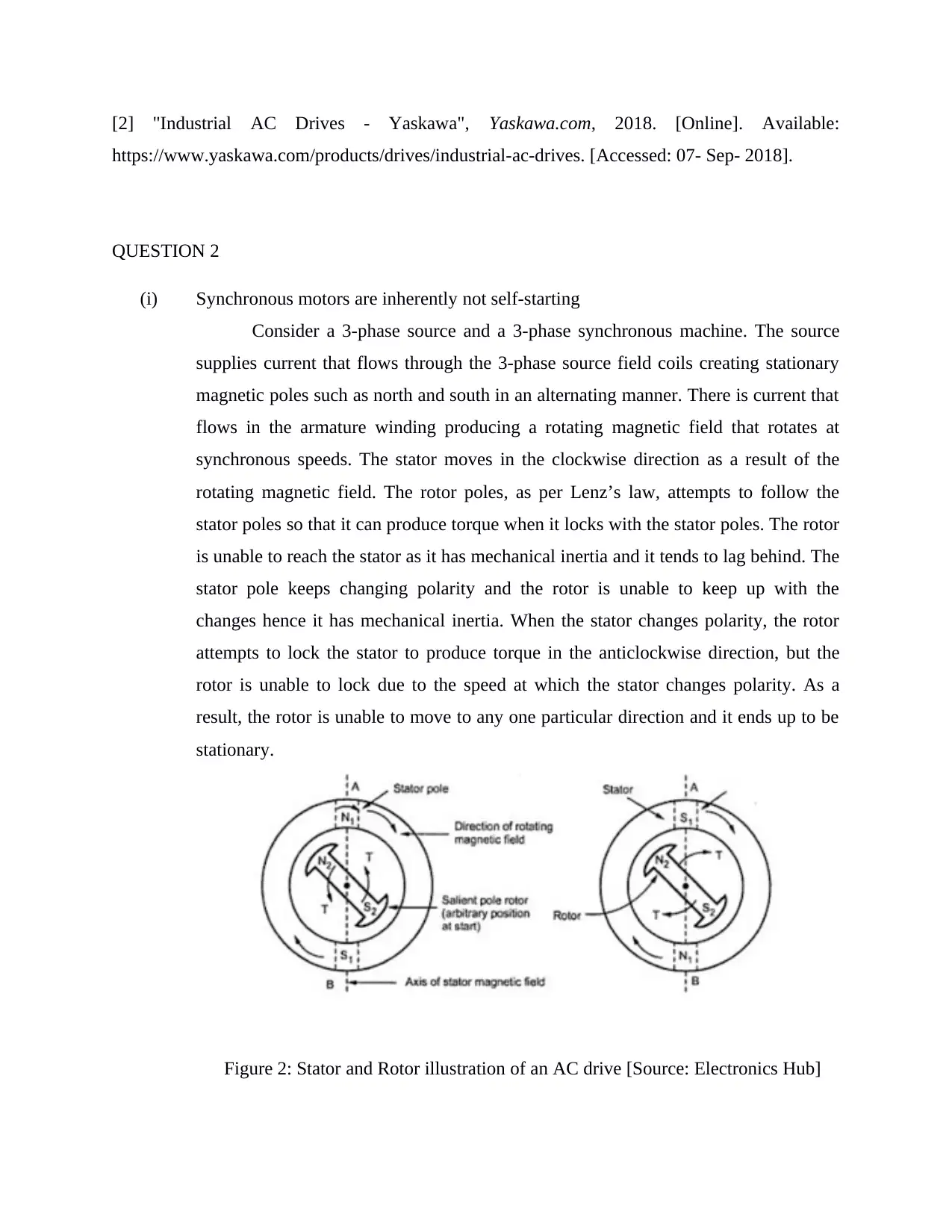
[2] "Industrial AC Drives - Yaskawa", Yaskawa.com, 2018. [Online]. Available:
https://www.yaskawa.com/products/drives/industrial-ac-drives. [Accessed: 07- Sep- 2018].
QUESTION 2
(i) Synchronous motors are inherently not self-starting
Consider a 3-phase source and a 3-phase synchronous machine. The source
supplies current that flows through the 3-phase source field coils creating stationary
magnetic poles such as north and south in an alternating manner. There is current that
flows in the armature winding producing a rotating magnetic field that rotates at
synchronous speeds. The stator moves in the clockwise direction as a result of the
rotating magnetic field. The rotor poles, as per Lenz’s law, attempts to follow the
stator poles so that it can produce torque when it locks with the stator poles. The rotor
is unable to reach the stator as it has mechanical inertia and it tends to lag behind. The
stator pole keeps changing polarity and the rotor is unable to keep up with the
changes hence it has mechanical inertia. When the stator changes polarity, the rotor
attempts to lock the stator to produce torque in the anticlockwise direction, but the
rotor is unable to lock due to the speed at which the stator changes polarity. As a
result, the rotor is unable to move to any one particular direction and it ends up to be
stationary.
Figure 2: Stator and Rotor illustration of an AC drive [Source: Electronics Hub]
https://www.yaskawa.com/products/drives/industrial-ac-drives. [Accessed: 07- Sep- 2018].
QUESTION 2
(i) Synchronous motors are inherently not self-starting
Consider a 3-phase source and a 3-phase synchronous machine. The source
supplies current that flows through the 3-phase source field coils creating stationary
magnetic poles such as north and south in an alternating manner. There is current that
flows in the armature winding producing a rotating magnetic field that rotates at
synchronous speeds. The stator moves in the clockwise direction as a result of the
rotating magnetic field. The rotor poles, as per Lenz’s law, attempts to follow the
stator poles so that it can produce torque when it locks with the stator poles. The rotor
is unable to reach the stator as it has mechanical inertia and it tends to lag behind. The
stator pole keeps changing polarity and the rotor is unable to keep up with the
changes hence it has mechanical inertia. When the stator changes polarity, the rotor
attempts to lock the stator to produce torque in the anticlockwise direction, but the
rotor is unable to lock due to the speed at which the stator changes polarity. As a
result, the rotor is unable to move to any one particular direction and it ends up to be
stationary.
Figure 2: Stator and Rotor illustration of an AC drive [Source: Electronics Hub]
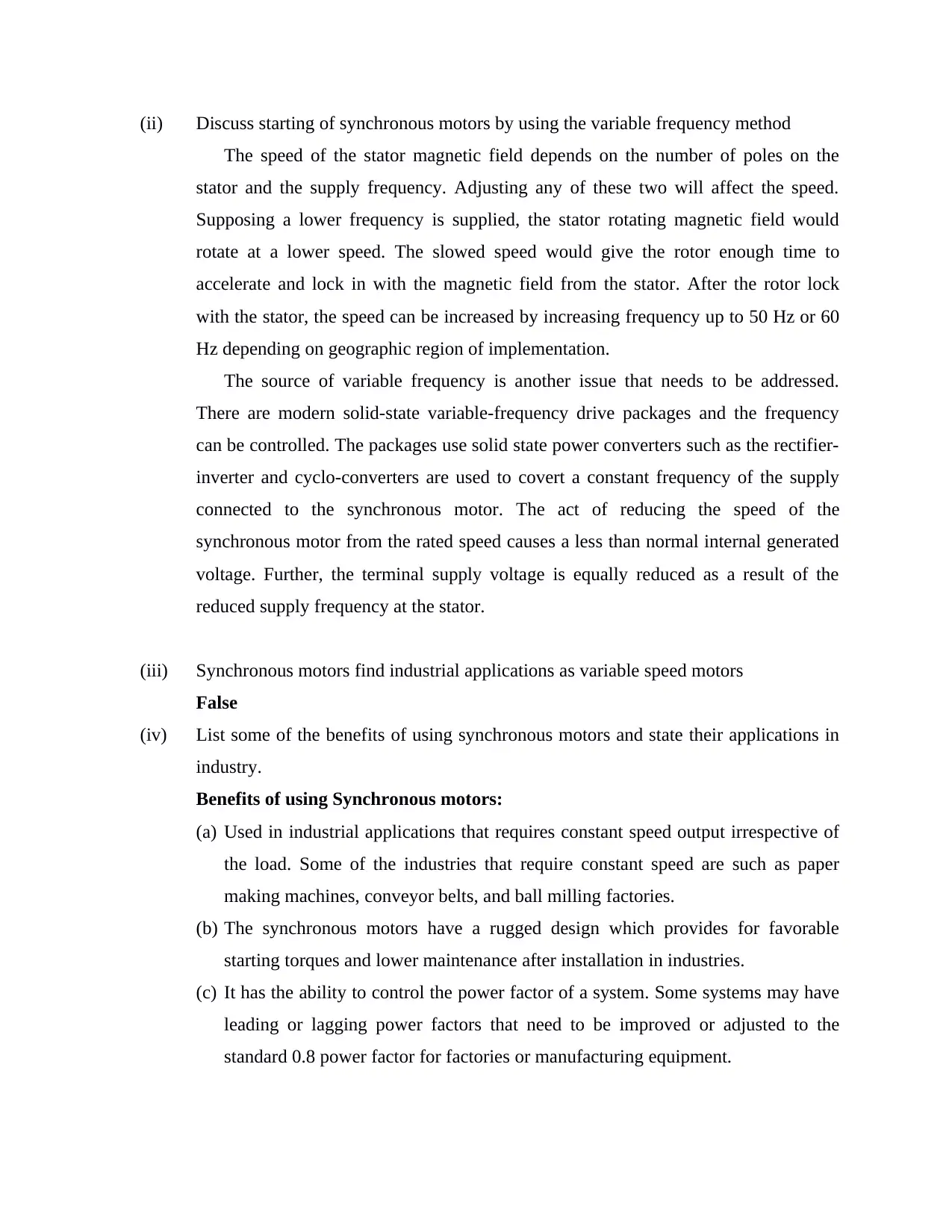
(ii) Discuss starting of synchronous motors by using the variable frequency method
The speed of the stator magnetic field depends on the number of poles on the
stator and the supply frequency. Adjusting any of these two will affect the speed.
Supposing a lower frequency is supplied, the stator rotating magnetic field would
rotate at a lower speed. The slowed speed would give the rotor enough time to
accelerate and lock in with the magnetic field from the stator. After the rotor lock
with the stator, the speed can be increased by increasing frequency up to 50 Hz or 60
Hz depending on geographic region of implementation.
The source of variable frequency is another issue that needs to be addressed.
There are modern solid-state variable-frequency drive packages and the frequency
can be controlled. The packages use solid state power converters such as the rectifier-
inverter and cyclo-converters are used to covert a constant frequency of the supply
connected to the synchronous motor. The act of reducing the speed of the
synchronous motor from the rated speed causes a less than normal internal generated
voltage. Further, the terminal supply voltage is equally reduced as a result of the
reduced supply frequency at the stator.
(iii) Synchronous motors find industrial applications as variable speed motors
False
(iv) List some of the benefits of using synchronous motors and state their applications in
industry.
Benefits of using Synchronous motors:
(a) Used in industrial applications that requires constant speed output irrespective of
the load. Some of the industries that require constant speed are such as paper
making machines, conveyor belts, and ball milling factories.
(b) The synchronous motors have a rugged design which provides for favorable
starting torques and lower maintenance after installation in industries.
(c) It has the ability to control the power factor of a system. Some systems may have
leading or lagging power factors that need to be improved or adjusted to the
standard 0.8 power factor for factories or manufacturing equipment.
The speed of the stator magnetic field depends on the number of poles on the
stator and the supply frequency. Adjusting any of these two will affect the speed.
Supposing a lower frequency is supplied, the stator rotating magnetic field would
rotate at a lower speed. The slowed speed would give the rotor enough time to
accelerate and lock in with the magnetic field from the stator. After the rotor lock
with the stator, the speed can be increased by increasing frequency up to 50 Hz or 60
Hz depending on geographic region of implementation.
The source of variable frequency is another issue that needs to be addressed.
There are modern solid-state variable-frequency drive packages and the frequency
can be controlled. The packages use solid state power converters such as the rectifier-
inverter and cyclo-converters are used to covert a constant frequency of the supply
connected to the synchronous motor. The act of reducing the speed of the
synchronous motor from the rated speed causes a less than normal internal generated
voltage. Further, the terminal supply voltage is equally reduced as a result of the
reduced supply frequency at the stator.
(iii) Synchronous motors find industrial applications as variable speed motors
False
(iv) List some of the benefits of using synchronous motors and state their applications in
industry.
Benefits of using Synchronous motors:
(a) Used in industrial applications that requires constant speed output irrespective of
the load. Some of the industries that require constant speed are such as paper
making machines, conveyor belts, and ball milling factories.
(b) The synchronous motors have a rugged design which provides for favorable
starting torques and lower maintenance after installation in industries.
(c) It has the ability to control the power factor of a system. Some systems may have
leading or lagging power factors that need to be improved or adjusted to the
standard 0.8 power factor for factories or manufacturing equipment.
⊘ This is a preview!⊘
Do you want full access?
Subscribe today to unlock all pages.

Trusted by 1+ million students worldwide
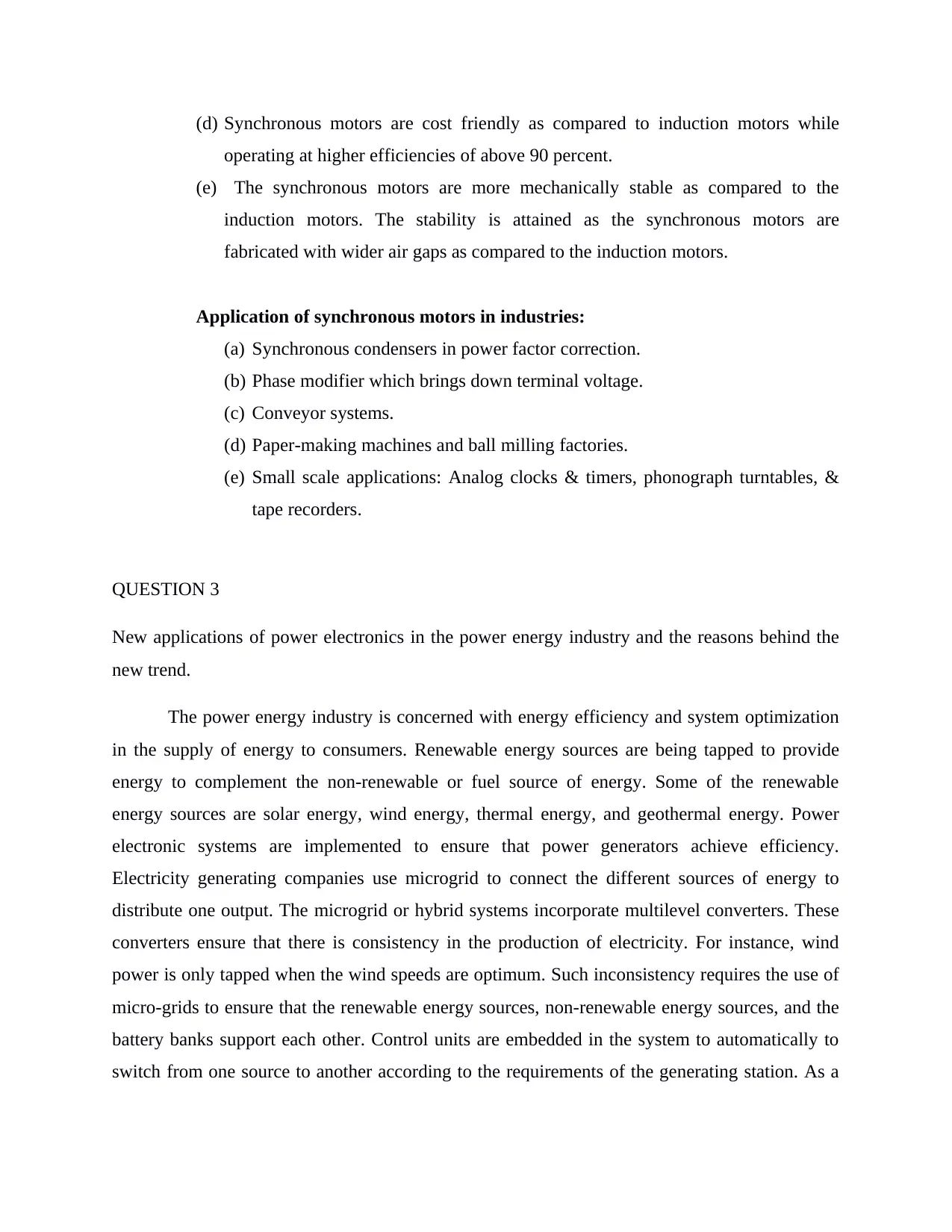
(d) Synchronous motors are cost friendly as compared to induction motors while
operating at higher efficiencies of above 90 percent.
(e) The synchronous motors are more mechanically stable as compared to the
induction motors. The stability is attained as the synchronous motors are
fabricated with wider air gaps as compared to the induction motors.
Application of synchronous motors in industries:
(a) Synchronous condensers in power factor correction.
(b) Phase modifier which brings down terminal voltage.
(c) Conveyor systems.
(d) Paper-making machines and ball milling factories.
(e) Small scale applications: Analog clocks & timers, phonograph turntables, &
tape recorders.
QUESTION 3
New applications of power electronics in the power energy industry and the reasons behind the
new trend.
The power energy industry is concerned with energy efficiency and system optimization
in the supply of energy to consumers. Renewable energy sources are being tapped to provide
energy to complement the non-renewable or fuel source of energy. Some of the renewable
energy sources are solar energy, wind energy, thermal energy, and geothermal energy. Power
electronic systems are implemented to ensure that power generators achieve efficiency.
Electricity generating companies use microgrid to connect the different sources of energy to
distribute one output. The microgrid or hybrid systems incorporate multilevel converters. These
converters ensure that there is consistency in the production of electricity. For instance, wind
power is only tapped when the wind speeds are optimum. Such inconsistency requires the use of
micro-grids to ensure that the renewable energy sources, non-renewable energy sources, and the
battery banks support each other. Control units are embedded in the system to automatically to
switch from one source to another according to the requirements of the generating station. As a
operating at higher efficiencies of above 90 percent.
(e) The synchronous motors are more mechanically stable as compared to the
induction motors. The stability is attained as the synchronous motors are
fabricated with wider air gaps as compared to the induction motors.
Application of synchronous motors in industries:
(a) Synchronous condensers in power factor correction.
(b) Phase modifier which brings down terminal voltage.
(c) Conveyor systems.
(d) Paper-making machines and ball milling factories.
(e) Small scale applications: Analog clocks & timers, phonograph turntables, &
tape recorders.
QUESTION 3
New applications of power electronics in the power energy industry and the reasons behind the
new trend.
The power energy industry is concerned with energy efficiency and system optimization
in the supply of energy to consumers. Renewable energy sources are being tapped to provide
energy to complement the non-renewable or fuel source of energy. Some of the renewable
energy sources are solar energy, wind energy, thermal energy, and geothermal energy. Power
electronic systems are implemented to ensure that power generators achieve efficiency.
Electricity generating companies use microgrid to connect the different sources of energy to
distribute one output. The microgrid or hybrid systems incorporate multilevel converters. These
converters ensure that there is consistency in the production of electricity. For instance, wind
power is only tapped when the wind speeds are optimum. Such inconsistency requires the use of
micro-grids to ensure that the renewable energy sources, non-renewable energy sources, and the
battery banks support each other. Control units are embedded in the system to automatically to
switch from one source to another according to the requirements of the generating station. As a
Paraphrase This Document
Need a fresh take? Get an instant paraphrase of this document with our AI Paraphraser
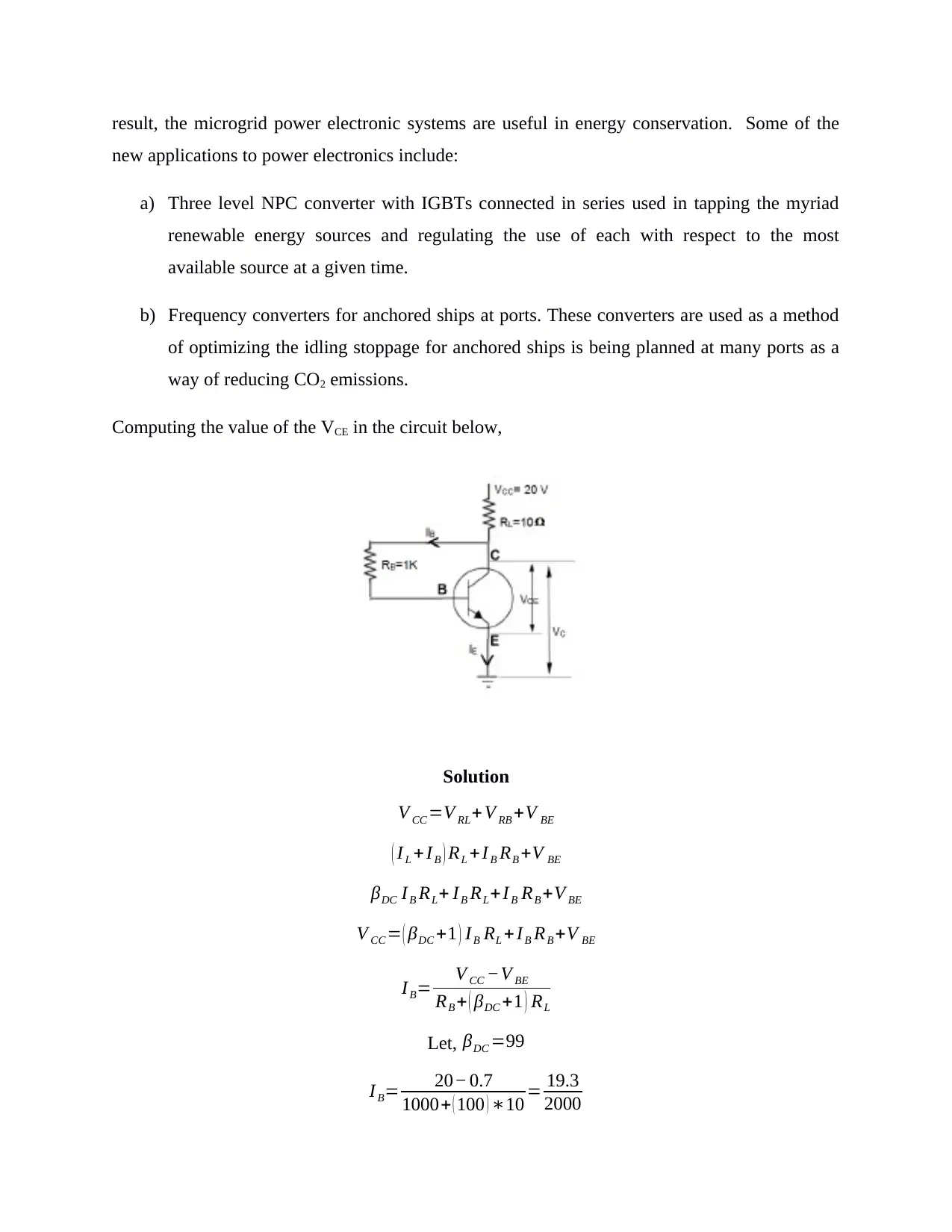
result, the microgrid power electronic systems are useful in energy conservation. Some of the
new applications to power electronics include:
a) Three level NPC converter with IGBTs connected in series used in tapping the myriad
renewable energy sources and regulating the use of each with respect to the most
available source at a given time.
b) Frequency converters for anchored ships at ports. These converters are used as a method
of optimizing the idling stoppage for anchored ships is being planned at many ports as a
way of reducing CO2 emissions.
Computing the value of the VCE in the circuit below,
Solution
V CC =V RL+ V RB +V BE
( I L + I B ) RL + I B RB +V BE
βDC IB RL+ IB RL+I B RB +V BE
V CC = ( βDC +1 ) IB RL + IB RB +V BE
IB= V CC −V BE
RB + ( βDC +1 ) RL
Let, βDC =99
I B= 20− 0.7
1000+ ( 100 ) ∗10 = 19.3
2000
new applications to power electronics include:
a) Three level NPC converter with IGBTs connected in series used in tapping the myriad
renewable energy sources and regulating the use of each with respect to the most
available source at a given time.
b) Frequency converters for anchored ships at ports. These converters are used as a method
of optimizing the idling stoppage for anchored ships is being planned at many ports as a
way of reducing CO2 emissions.
Computing the value of the VCE in the circuit below,
Solution
V CC =V RL+ V RB +V BE
( I L + I B ) RL + I B RB +V BE
βDC IB RL+ IB RL+I B RB +V BE
V CC = ( βDC +1 ) IB RL + IB RB +V BE
IB= V CC −V BE
RB + ( βDC +1 ) RL
Let, βDC =99
I B= 20− 0.7
1000+ ( 100 ) ∗10 = 19.3
2000
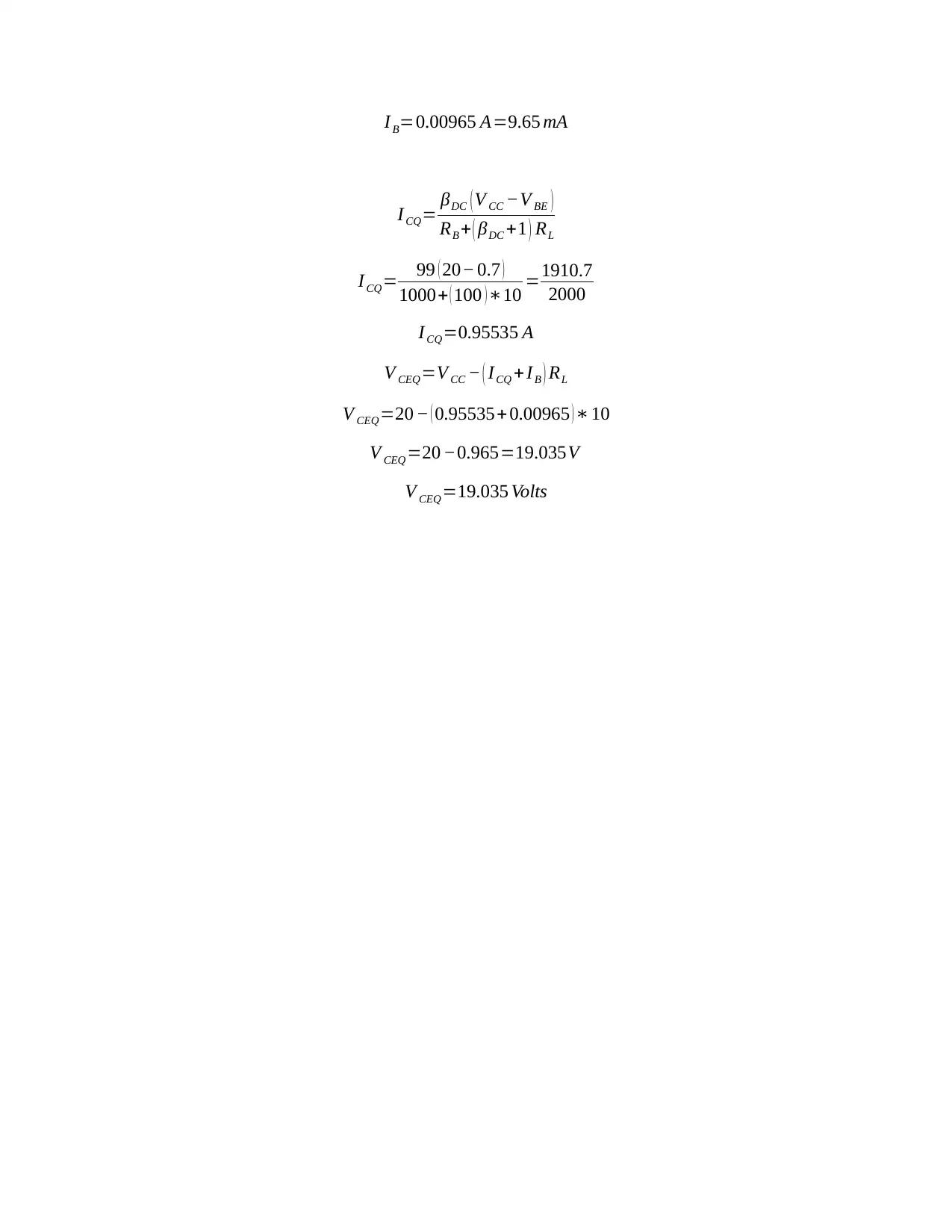
I B=0.00965 A=9.65 mA
I CQ= βDC ( V CC −V BE )
RB + ( βDC +1 ) RL
I CQ= 99 ( 20− 0.7 )
1000+ ( 100 ) ∗10 =1910.7
2000
I CQ=0.95535 A
V CEQ=V CC − ( ICQ +IB ) RL
V CEQ=20 − ( 0.95535+0.00965 ) ∗ 10
V CEQ=20 −0.965=19.035V
V CEQ=19.035 Volts
I CQ= βDC ( V CC −V BE )
RB + ( βDC +1 ) RL
I CQ= 99 ( 20− 0.7 )
1000+ ( 100 ) ∗10 =1910.7
2000
I CQ=0.95535 A
V CEQ=V CC − ( ICQ +IB ) RL
V CEQ=20 − ( 0.95535+0.00965 ) ∗ 10
V CEQ=20 −0.965=19.035V
V CEQ=19.035 Volts
⊘ This is a preview!⊘
Do you want full access?
Subscribe today to unlock all pages.

Trusted by 1+ million students worldwide
1 out of 9
Related Documents
Your All-in-One AI-Powered Toolkit for Academic Success.
+13062052269
info@desklib.com
Available 24*7 on WhatsApp / Email
![[object Object]](/_next/static/media/star-bottom.7253800d.svg)
Unlock your academic potential
Copyright © 2020–2025 A2Z Services. All Rights Reserved. Developed and managed by ZUCOL.




